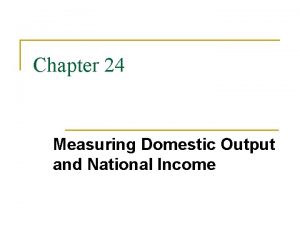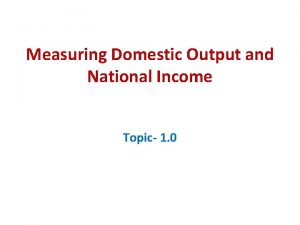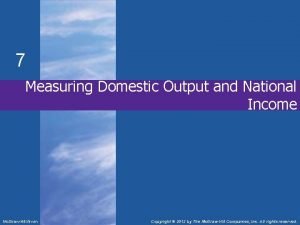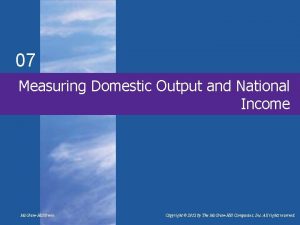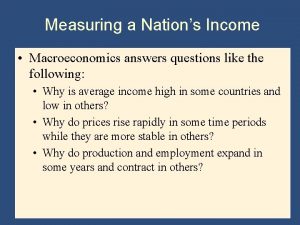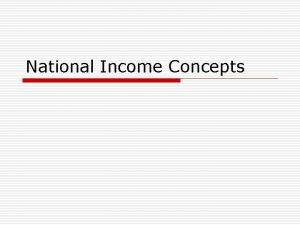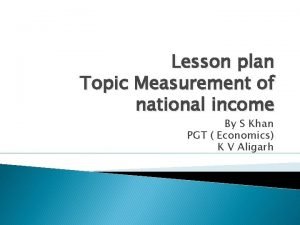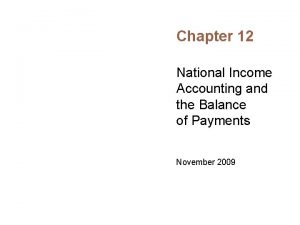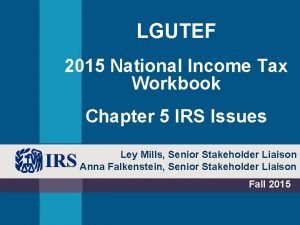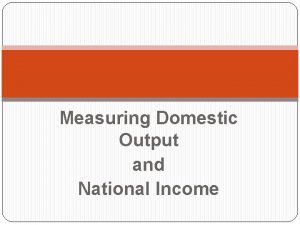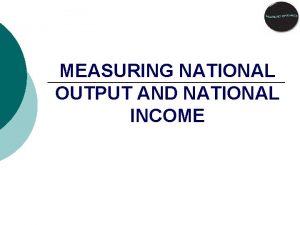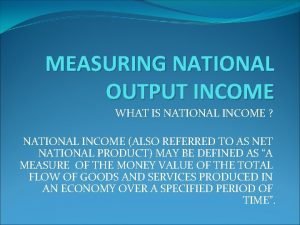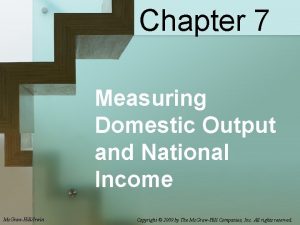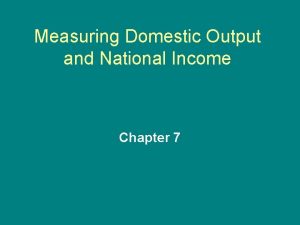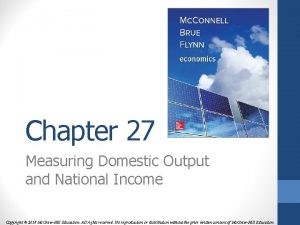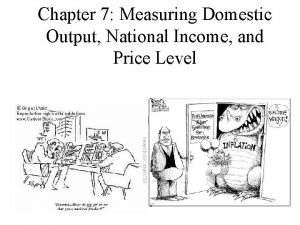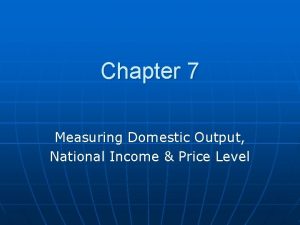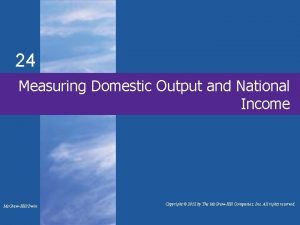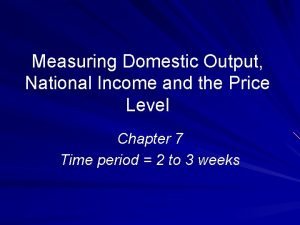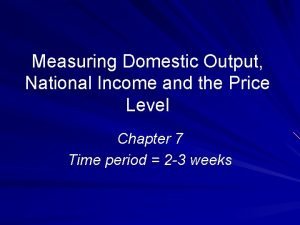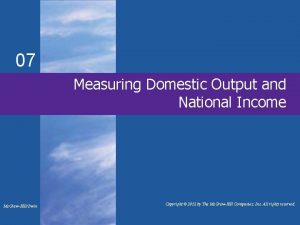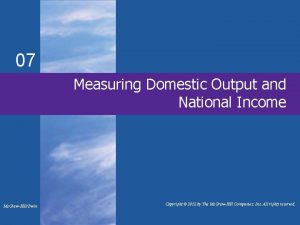Chapter 25 Measuring Domestic Output and National Income


















- Slides: 18

Chapter 25 Measuring Domestic Output and National Income Copyright © 2015 Mc. Graw-Hill Education. All rights reserved. No reproduction or distribution without the prior written consent of Mc. Graw-Hill Education.

Assessing the Economy’s Performance • National Income Accounting measures economy’s overall performance • Bureau of Economic Analysis compiles National Income and Product Accounts • Assess health of economy • Track long run course • Formulate policy LO 1 25 -2

Gross Domestic Product • Measure of aggregate output • Monetary measure • Avoid multiple counting • Market value final goods • Ignore intermediate goods • Count value added LO 1 25 -3

Gross Domestic Product • Exclude financial transactions • Public transfer payments • Private transfer payments • Stock market transactions • Exclude second hand sales • Sell used car to a friend LO 1 25 -4

Two Approaches to GDP • Income approach • Count income derived from production • Wages, rental income, interest income, profit • Expenditure approach • Count sum of money spent buying the final goods • Who buys the goods? LO 1 25 -5

Expenditures Approach • Personal consumption expenditures (C) • Durable goods • Nondurable goods • Consumer expenditures for services • Domestic plus foreign goods produced LO 2 25 -6

Expenditures Approach • Gross private domestic investment (Ig) • Machinery, equipment, and tools • All construction • Positive and negative changes in inventories • Creation of new capital assets • Noninvestment transactions excluded LO 2 25 -7

Expenditures Approach - = Gross Investment Depreciation Net Investment Gross Investment Net Investment Depreciation Stock of Capital January 1 LO 2 Consumption, government expenditures, and net exports of Capital Year’s GDP December 31 25 -8

Expenditures Approach LO 2 • Government purchases (G) • Expenditures for goods and services • Expenditures for publicly owned capital • Excludes transfer payments • Net exports (Xn) • Add exported goods • Subtract imported goods • Xn= exports (X) – imports (M) • GDP = C + Ig + G + Xn 25 -9

The Income Approach • • • Compensation of employees Rents Interest Proprietor’s income Corporate profits • Corporate income taxes • Dividends • Undistributed corporate profits • Taxes on production and imports LO 3 25 -10

The Income Approach LO 3 • From national income to GDP • Subtract net foreign factor income • Statistical discrepancy • Consumption of fixed capital • Other national accounts • Net domestic product (NDP) • National income (NI) • Personal income (PI) • Disposable income (DI) 25 -11

Circular Flow Revisited LO 4 25 -12

Nominal GDP vs. Real GDP • GDP is a dollar measure of production • Using dollar values creates problems • Nominal GDP • Based on prices that prevailed when output was produced • Real GDP • Reflect changes in the price level • Use base year price LO 5 25 -13

GDP Price Index • Use price index to determine real GDP Price Index In Given Year Real GDP LO 5 = = Price of Market Basket In Specific Year Price of Same Basket In Base Year x 100 Nominal GDP Price Index (in hundredths) 25 -14

Shortcomings of GDP • • LO 6 Nonmarket activities Leisure Improved product quality The underground economy GDP and the environment Composition and distribution of the output Noneconomic sources of well-being 25 -15

Sources of BEA Data • Consumption • Census Bureau’s Retail Trade Survey • Census Bureau’s Survey of Manufacturers • Census Bureau’s Service Survey • Industry Trade Sources 25 -16

Sources of BEA Data • Investment • All consumption data sources • Census Bureau’s Housing Starts Survey and Housing Sales Survey • Retail Trade Survey • Wholesale Trade Survey • Survey of Manufacturing 25 -17

Sources of BEA Data • Government Purchases • Office of Personnel Management • Construction Surveys • Census Bureau’s Survey of Government Finance • Net Exports • U. S. Customs Service • BEA Surveys and Analysis 25 -18
 Measuring domestic output and national income
Measuring domestic output and national income Measuring domestic output and national income
Measuring domestic output and national income Measuring domestic output and national income
Measuring domestic output and national income Measuring domestic output and national income
Measuring domestic output and national income Gdp calculation expenditure approach
Gdp calculation expenditure approach Difference between gdp and gnp
Difference between gdp and gnp Measuring a nation's income
Measuring a nation's income Deferred tax asset journal entry
Deferred tax asset journal entry Operating activities
Operating activities Calculate income tax
Calculate income tax National income and product accounts
National income and product accounts Chapter 7 domestic and family violence assessment
Chapter 7 domestic and family violence assessment Kilala sa tawag na gross national product
Kilala sa tawag na gross national product National income concepts
National income concepts Lesson plan on national income
Lesson plan on national income National income formula
National income formula Lgutef
Lgutef Linear algebra
Linear algebra Final expenditure approach
Final expenditure approach
